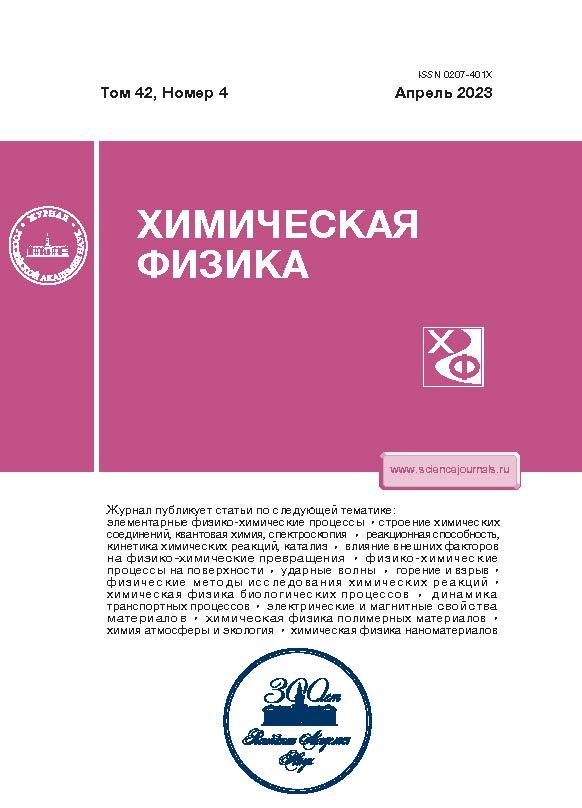Influence of Gas-Dispersion Parameters of the Air Suspension Flow on the Flame Spread Velocity
- Authors: Egorov A.G.1, Tizilov A.S.1
-
Affiliations:
- Togliatti State University,
- Issue: Vol 42, No 4 (2023)
- Pages: 47-56
- Section: Combustion, explosion and shock waves
- URL: https://rjmseer.com/0207-401X/article/view/674878
- DOI: https://doi.org/10.31857/S0207401X23040076
- EDN: https://elibrary.ru/MWUNTF
- ID: 674878
Cite item
Abstract
The results of experimental studies on the effect of gas-dispersed parameters of the flow of an air suspension of aluminum particles—the average particle diameter d32 and excess air coefficient α—on the flame propagation velocity are presented. The dependences of the apparent flame propagation velocity, uf, on the coefficient of excess air α for ASD-1-grade aluminum powder with d32 = 17.4 µm and ASD-4-grade aluminum powder with d32 = 7.4 µm are obtained. It is established that the number of maxima and their location on the dependence graph uf(α) depend on the particle combustion mode, which in turn is determined by the particle size. For both powder grades, there is a maximum on the dependence graph uf(α) in the rich region (α ≈ 0.2). For aluminum particles with d32 = 17.4 µm, the flame propagation velocity decreases monotonically with increasing α. For particles with d32 = 7.4 µm, whose combustion occurs in the kinetic mode, there is a second maximum in the region of stoichiometric air suspension compositions (α ≈ 1.0). The number and location of maxima and their variation depending on the average diameter d32 allows us to draw certain conclusions about the combustion mechanism of aluminum particles.
About the authors
A. G. Egorov
Togliatti State University,
Email: eag@tltsu.ru
Togliatti, Russia
A. S. Tizilov
Togliatti State University,
Author for correspondence.
Email: eag@tltsu.ru
Togliatti, Russia
References
- Воронецкий А.В., Крылов В.И., Арефьев К.Ю., Гусев А.А. // Инж. журн.: наука и инновации. 2017. № 1(61). С. 2.
- Алексеев А.Г., Судакова И.В. // Физика горения и взрыва. 1983. Т. 19. № 5. С. 34.
- Егоров А.Г. Процессы горения порошкообразного алюминия в прямоточных камерах реактивных двигательных установок. Самара: Изд-во СНЦ РАН, 2004.
- Малинин В.И. Внутрикамерные процессы в установках на порошкообразных металлических горючих. Екатеренбург–Пермь: УрО РАН, 2006.
- Ягодников Д.А. Воспламенение и горение порошкообразных металлов. М.: Изд-вo МГТУ им. Н.Э. Баумана, 2009.
- Махов М.Н. // Хим. физика. 2020. Т. 39. № 9. С. 71; https://doi.org/10.31857/S0207401X20090083
- Коротких А.Г., Сорокин И.В., Селихова Е.А., Архипов В.А. // Хим. физика. 2020. Т. 39. № 7. С. 32; https://doi.org/10.31857/S0207401X20070080
- Шмелев В.М. // Хим. физика. 2020. Т. 39. № 8. С. 75; https://doi.org/10.31857/S0207401X20080099
- Вадченко С.Г., Алымов М.И. // Хим. физика. 2022. Т. 41. № 3. С. 22; https://doi.org/10.31857/S0207401X2203013X
- Кудрявцев В.М., Сухов А.В., Воронецкий А.В., Пеньков С.Н. // Высокотемпературные газовые потоки, их получение и диагностика. Вып. 4. Харьков: ХАИ, 1986. С. 66.
- Моисеева К.М., Крайнов А.Ю., Дементьев А.А. // Физика горения и взрыва. 2019. Т. 55. № 4. С. 26.
- Huang Y., Risha G.A., Yang V., Yetter R.A. // Combust. and Flame. 2009. V. 156. № 1. P. 5.
- Афанасьев С.Н., Жарков В.Ю., Озеров Е.С. // Физика аэродисперсных систем. Вып. 27. Киев, Одесса: Вища шк., 1985. С. 39.
- Goroshin S., Palečka J., Bergthorson J. // Prog. Energy Combust. Sci. 2022. V. 91. 100994; https://doi.org/10.1016/j.pecs.2022.100994
- Кудрявцев В.М., Сухов А.В., Воронецкий А.В., Шпара А.П. // Физика горения и взрыва. 1981. Т. 17. № 6. С. 49.
- Bocanegra E.P., Sarou-Kanian V., Davidenko D., Chauveau C., Gökalp I. // Prog. Propulsion Phys. 2009. V. 1. P. 47.
- Risha G.A., Huang Y., Yetter R.A., Yang V. // 43rd AIAA Aerospace Sciences Meeting and Exhibit. Reno, Nevada, 2005. AIAA Paper 2005-739.
- Бойчук Л.В., Шевчук В.Г., Швец А.И. // Физика горения и взрыва. 2002. Т. 38. № 6. С. 51.
- Goroshin S., Fomenko I., Lee J.H.S. // Proc. 26th Sympos. (Intrern.) on Combust. V. 26. Pittsburgh: The Combust. Inst. 1996. 2. P. 1961.
- Гринчук П.С. // Физика горения и взрыва. 2014. Т. 50. № 3. С. 32.
- Kobayashi H., Ono NOkuyama Y., Niioka T. // Proc. 25th Sympos. (Intern.) on Combustion. V. 25. Pittsburgh: The Combust. Inst., 1994. P. 1693.
- Щетинков Е.С. Физика горения газов. М.: Наука, 1965.
- Полетаев Н.И. // Физика горения и взрыва. 2016. Т. 52 № 6. С. 60.
- Тизилов А.С., Егоров А.Г. // Хим. физика. 2013. Т. 32. № 3. С. 35.
- Егоров А.Г. // Физика горения и взрыва. 2020. Т. 56. № 1. С. 48.
- Ягодников Д.А., Сухов А.В., Малинин В.И., Кирьянов И.М. // Вестн. МГТУ. “Сер. Машиностроение”. 1990. № 1. С. 121.
- Озерова Г.Е., Степанов И.М. // Физика горения и взрыва. 1973. Т. 5. № 2. С. 627.
- Тодес О.М., Гольцикер А.Д., Ионушас К.К. // Физика горения и взрыва. 1974. Т. 10. № 1. С. 83.
- Агеев Н.Д., Горошин С.В., Золотко А.Н., Полетаев Н.И., Шошин Ю.Л. // Горение гетерогенных и газовых систем. Матер. IX Всесоюз. симпоз. по горению и взрыву. Черноголовка: ОИХФ АН СССР, 1989. С. 83.
- Полетаев Н.И. Пылевые пламена металлов: получение, свойство, применение. Дис. … д-ра физ-мат. наук. Одесса: ОНУ им. И.И. Мечникова, 2013.
- Ярин Л.П. Основы теории горения двухфазных сред. Л.: Энергоатомиздат. Ленингр. отд-ние, 1987.
- Мальцев В.М., Мальцев М.И., Кашпоров Л.Я. Основные характеристики горения. М.: Химия, 1977.
Supplementary files


















